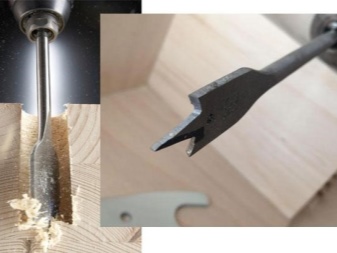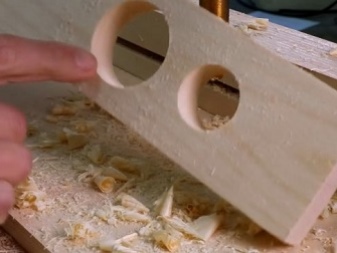All About Pen Drills

Drill bit - one of the types of cutting tools in order to form a hole of certain shape and depth in surfaces of various materials. The gimbals have various shapes - cone, steps, feather, screw and many others. It depends on what material you are working with and what hole you need to drill.
Feather nozzles are good for working with wood, metal, porcelain stoneware, tiles, glass, plastic. It is important to choose the right accessory and work in accordance with the rules for the operation of the tool.


Peculiarities
Most often drilling - this is the formation of through holes in the surface. But, in addition to this, two more types of actions are possible - reaming of already finished holes (this means that their diameter increases), as well as drilling - the formation of holes that do not go through the surface of the material. The drill can be fixed in various types of equipment - electric drill, hammer drill, machine tool. It is these tools that bring the drill into working condition, namely: it begins to make rotational movements, and thanks to them, chips are removed from the material.


This happens through the action of cutting edges of various configurations. You need to understand that drilling is not only cutting materials, but also crushing them. That is why you should carefully select a gimbal for each type of surface - porcelain stoneware, glass, plastic, concrete and others.
An incorrectly selected drill bit can split or damage the surface and cannot be repaired.


The structure of a pen drill includes a rod, on one side of which there is a working surface that resembles a pen (hence the name). The other side of the product ends with a hexagonal tip. In the "pen" there are two incisors attached to the central point. There are two types of pen drills: 1-sided and 2-sided. The former can work only in one direction, the latter, respectively, in both directions. The cutter angles differ between 1-sided and 2-sided drills. In the former, they are a maximum of 90 degrees, while in the latter they fluctuate between 120 and 135 degrees.
The advantage of this type of gimbal is the optimal combination of price and quality of the product. Despite the fact that the price for them is quite affordable, the range of possibilities of such a drill is quite wide. GOST 25526-82 for the manufacture of pen drills has not changed over the years, being a kind of "hello" from the Soviet times, as it was approved in 1982.


Species overview
Depending on what material you plan to work with, the choice of drill also differs: it can be a product for working on metal, wood, or porcelain stoneware. Wood drills are distinguished by their high productivity when compared to standard spiral gimbals. The first nozzle can perfectly drill holes with a large diameter, and it is suitable for working with both ordinary wood and glued wood.
If you need to drill or re-drill plastic or drywall, you will also need a woodworking attachment. But it has one drawback - it does not have high quality and accuracy of work, therefore it can only be used for drilling simple, unclean holes. In the future, they will need to be sanded and cleaned to give perfect evenness.


If we talk about drills for metal (it does not matter, solid or equipped with replaceable cutting plates), then they are optimal for drilling holes with great depths of various shapes on steel, cast iron and other metal surfaces.

The pen nozzle fits well with any tool, which provides for the presence of an appropriate cartridge for its fastening, that is, with a hand or electric drill, machine tool, perforator. Those who love and know how to work with metal can create various crafts using this attachment - it is suitable for this.
There is another type of pen drills - adjustable... They help provide flexibility in the drilling process. The feather has a wedge-shaped blade. The blade has a lock and a slow-feed screw, thanks to which the drilling adjustment is provided. If you need to punch a large number of holes with different diameters, the adjustable nib is the best choice. It can be used to drill hard and medium-soft wood, as well as chipboard and drywall.
As a rule, hardened steel is used for the manufacture of such drills, and in order to drill more accurately, they are equipped with centering tips.


How to choose?
First you need to decide what material you will work with. Based on this, it is necessary to choose a feather nozzle. A corresponding marking is applied to each of them - it can be 3, 6, 9 and even 10. This number indicates with what diameter (in millimeters) the drilling will be carried out. It is also important what kind of shank the nozzle has - it depends on whether it is suitable for any tool (be it a drill or screwdriver) or not.
Three-sided shanks will fit any chuck. If the shank has an SDS modification, it will be possible to “mount” it only with a hammer drill, for which it is, in fact, designed. It is also very important to pay attention to the color that the drill has. If it is gray, it means that the steel from which it is made is not hardened, that is, the product is rather fragile and will not be suitable for strong materials such as tiles or tiles.

The black color of the nozzle indicates that it has undergone an oxidation procedure, that is, a hot steam treatment. Thanks to this treatment, the product is protected from corrosion and overheating, it becomes more durable. Light gilding on the drill indicates that it has passed the tempering procedure... And bright gilding - that the tip is coated with titanium nitride or titanium carbonitridemaking it suitable for the most durable materials.
It must be remembered that drills on which spraying or abrasive is applied will last much longer than products without spraying, but it will not be possible to sharpen them. The most durable will be a diamond-coated drill - it can be used to make holes even in concrete.


Operating rules
There are a number of little things to consider when using drills. Starting drilling, you should make a rough outline of the place for drilling, or better - make a deepening of a shallow depth. It is preferable to use a drill on which the number of revolutions can be adjusted. It is important to remember the general rule: the larger the diameter of the nozzle, the lower its rotation speed should be. If you operate it at high speed, the cutters will wear out much faster, or the bit itself will break.


If you are planning to drill deep holes, then you should immediately get an extension cord with a special lock. The lock is fixed with a hex key, so the attachment and extension are turned into a single mechanism. To accurately outline the contours of the future hole, it is advisable to work at a very low speed (this is the beginning of the drilling process).To prevent the nozzle from breaking and causing damage to the material being processed, it must be kept clearly at an angle of 90 degrees to the surface.
Do not press on the tip, the pressure should be light. When working with a feather drill for wood, it is important to take into account that all the sawdust remains inside the hole, it does not come out on its own. In order for the drilling to go according to the planned plan, you need to periodically turn off the drill or screwdriver and rake the sawdust out of the hole.



How to sharpen?
Any tool, if purchased for use, becomes unusable over time. Pen tips are no exception, especially when working with metal surfaces where how sharp the tool is is critical. An insufficiently sharpened drill can damage the surface, and it is not always possible to drill a hole of the required diameter if the nozzle is dull.
There are several signs that a gimbal is in urgent need of sharpening:
- the drill works slower than usual, and does not enter the material evenly;
- the product gets very hot during operation;
- instead of cutting the material, the nozzle “chews” it;
- in the process of drilling, the gimbal makes loud sounds - creaking and squealing;
- the drilled holes are far from ideal - they have "torn", uneven edges, and inside they are rough to the touch.

In most cases, such products are thrown away, because, as their owners rightly argue, it is easier and faster to buy a new one than to spend time and effort sharpening. However, for those who are used to using all the available tools to the maximum, it will not be a problem to make a device for sharpening drills, especially since every craftsman has tools for this.
Of course, if the nozzle is severely deformed, then it is not worth spending time on restoring it.
See the next video on how to choose a nib drill.













The comment was sent successfully.